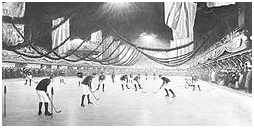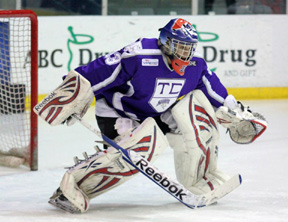Indoor Ice
Hockey originated as an outdoor sport and in colder climates continues to be
played outdoors. When was the ice brought indoors? When was the first indoor
hockey game played?
The
first indoor ice arena opened in London, England, in 1876. It was called the
Glaciarium. Three years later the United States opened its first indoor ice
rink at Madison Square Gardens. But these were just ice skating rinks.
The real first belongs to
Canada where the first indoor ice hockey game was played on March 3, 1875.
This game took place in Montreal at the Victoria Skating Rink. There were
nine members on each team. They used the same kind of sticks and skates that
were used outdoors, but the puck was made of wood.
Victoria Ice Skating Rink was 204 feet long and 80 feet wide. The ice was
surrounded by a 10-foot wide platform built a foot above ice level.
Spectators could sit here or the skaters could rest.

1893 hockey game at the Victoria Skating Rink in Montreal, Canada
Modern day arenas and
successful indoor hockey games got started in Canada in the early 1900’s
when the Patrick brothers created hockey leagues. They opened their first
arena in Victoria, Canada, on Christmas Day in 1912. It cost $110,000 and
had a seating capacity of 4,000. A few days later they opened a second one
in Vancouver. It cost $210,000 and would seat 10,000 people. They then
proceeded to build more arenas across the northwestern United States and
western Canada. Today, of course, a new arena costs hundreds of millions of
dollars to build.
Some Facts about the Ice
The world’s first ice surface
to be frozen by mechanical means was the Glaciarium in London England. This
modern marvel, built in 1876 by John Gamgee, was accomplished by an indirect
refrigeration system utilizing glycerin as the secondary coolant and ether
as the primary coolant
The system for keeping the ice on the floor of an arena is basically a huge
refrigerator. It works on the same principal anyway.
“The main difference in an ice rink, other than sheer size, is that the
refrigerant doesn't cool the ice directly. Instead, it cools brinewater, a
calcium-chloride solution, which is pumped through an intricate system of
pipes underneath the ice. In most rinks, the pipes are embedded in a
concrete or sand base”(1)
Or now it may be glycol which is antifreeze that
is chilled and continuously flows through those pipes.
There is about 10 miles of piping under the concrete which keeps the surface
at about 16 degrees for playing hockey. The ice ideally needs to about ¾
inch thick to attain the proper hardness for playing hockey. If it is
thicker the ice will be softer and slower. Typically there will be 15,000
gallons of frozen water on the cement surface of an ice arena for a hockey
game.
Why is the surface
of indoor ice so much smoother and more even than the ice on an outdoor
pond? An ice conditioning machine, commonly called a Zamboni, is used. It scrapes up loose shavings and puts
down a layer of hot water which will be frozen within minutes.
(1)http://www.howstuffworks.com/ice-rink.htm
http://www.falmouthicearena.com/funfacts.htm
|
|

